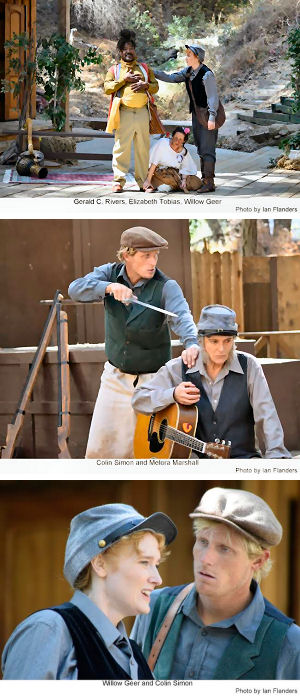
 This was a double play weekend. Our first play was a comedy, Four Clowns Present Hamlet, on Friday night. Our second play was a drama: The Diviners by Jim Leonard Jr. at REP East (FB), which we saw last night. Sometimes, with double-play weekend, I’m able to figure out a connection between the two shows we see. This weekend? It’s hard to see any connection between a classic drama about revenge (performed by clowns), and a slice of life in 1930s Indiana about a mentally-damaged boy and his relationship with water.
This was a double play weekend. Our first play was a comedy, Four Clowns Present Hamlet, on Friday night. Our second play was a drama: The Diviners by Jim Leonard Jr. at REP East (FB), which we saw last night. Sometimes, with double-play weekend, I’m able to figure out a connection between the two shows we see. This weekend? It’s hard to see any connection between a classic drama about revenge (performed by clowns), and a slice of life in 1930s Indiana about a mentally-damaged boy and his relationship with water.
Going in, with a title like The Diviners, what would you expect? I was expecting something like 110 in the Shade or The Rainmaker — that is, something about a community during a drought, and a need for water. A subject that would be very timely, given the current situation in California. Even the short description seems to give the drought emphasis: “The boy was deeply traumatized by a near-drowning in his past and as a result is deathly afraid of water, but ironically is also gifted with the ability to divine the location of water — sorely needed in his drought-besieged community.” But the actual act of “divining” only occurs in one scene, although there is a lot of mention of water. Further, there is only one character with the ability to divine water. So why is the title plural? Let’s see if we can figure that out in a minute.
So if The Diviners isn’t about the process of divination in a drought-ravaged community, what is it about? The folks we came with (who don’t particularly like this play) would say… nothing. It is a slice of life play, nothing more. I would tend to disagree with them. Yes, it is a slice of life in 1930s Zion Indiana; an exploration of a community that is desperately in need. For the farmers, that need is water — although it is less water in the form of wells, and more water in the form of the rain that nourishes their crops. For the townsfolk, that need is a different type of drought — they are in a spiritual drought after the church burned down many years ago. The desperately want that revival spirit back, and are searching for anything to do it.
At the center of the story is the Layman family: father Ferris and children Buddy and Jennie Mae. After an unfortunate near-drowning incident, Buddy was left mentally damaged but with a unique ability: he could sense water. This gave him the power of divination in the traditional sense (i.e., dowsing for water), but it also gave him the ability to sense when much needed storms were coming. It also left him with a tremendous fear of water — particularly cold water. It also left him with a strong desire for his mother, as he was unable to understand that she gave her life saving his. Into this family comes C.C. Showers, a man from Kentucky who has given up being a preacher because he no longer felt the calling. C.C. quickly bonds with this family and starts working for Ferris in his automotive repair shop. He also bonds with Buddy, becoming his friend, and with Jennie Mae. Jennie Mae wants the bond to be romantic; C.C. strives hard to keep it from becoming that because of their difference in ages: he is 30, she is 17.
Surrounding these people are the other residents of Zion, IN. Basil and Luella Bennett are farmers, with two farmhands Melvin Wilder and Dewey Maples. Basil’s concern is his farm: he’s searching for rain for the crops, and the best way to work the land (he does not care for modern equipment). Dewey’s concern is the daughter of the Dry Goods proprietor, Darlene Henshaw. Complicating this is Darlene’s mother, Norma Henshaw: a bible-thumpin’ woman who wants to see the town come back to a stronger faith. Also strongly faithful is Goldie Short, who runs the local diner: she insists on prayer before every meal. Together, Norma, Goldie, and Luella are a bunch of church ladies in search of a church and a pastor.
The play itself is a slice of life: it opens with Basil and Dewey talking about finding Buddy’s body in the river, and going to tell his father. The play then takes place as an extended flashback starting at the arrival of C.C., and continuing until the first scene is essentially repeated. During the play, we see the growth and change in Buddy, and the start of a relationship between C.C. and Jennie Mae. This is what you want to see in a good play.
Unfortunately, what you also want to see is a resolution, and it is in this sense that the story itself falls a little flat. You want to see C.C. help Buddy overcome his fear of water, and finally understand what happens to his mother. This is cut short by Buddy’s death. You want to see the relationship between C.C. and Jennie Mae succeed (even with the age difference) because they seem to fit well together. However, you are left dangling because there is no formal resolution; in fact, it looks like the circumstances of Buddy’s death would push them apart instead of together. As a result, you walk out a little unsatisfied — not from the performances (which were excellent — more on that below), but from the denouement. The resolution doesn’t uplift you as you might hope. You are left searching for something that might not be there.
This brings us back to the title. Why is The Diviners plural? After all, at the surface, The Diviners is about only one diviner: Buddy Layman. But in the broader sense of “divination” being a search for something that may or may not be there, the town is a town of diviners: the church ladies are searching for a church; the farmers are searching for rain; Jennie Mae is searching for love; Buddy is searching for his mom — and a stop to his itching; and C.C…. well, C.C. is searching for a purpose — a meaning for his life without preaching but still with a gift to reach people. The audience is also searching: searching for an uplifting resolution that they ultimately don’t get.
There, my friends, is the connection between the two plays this weekend. Hamlet, ultimately, is a tragedy: everyone touched is destroyed except for Horatio. The Diviners, too, is a tragedy: everyone touched by Buddy is destroyed, in some sense, by his death. Certainly, the hopes that had begun to blossom — for love, for spirituality, for healing — are killed as dead as King Claudius and Queen Gertrude. In Hamlet, the endless push for revenge is seen as destructive in the end. In The Diviners, it is the excessive search for something that really isn’t there that is destructive. That something, by the way, isn’t water.
The performances in The Diviners were top notch. As always, some percentage of the credit should go to the director, Jeff Johnson (FB), who drew out extremely realistic performances from his acting ensemble and (presumably) conceived the design of the overall production for the REP space. Whatever he did, it worked: this was REP back at the top of its performance game. Whatever the faults of this story, you should see it for the quality of the performances on the stage — it demonstrates how REP is the best professional theater in the northern part of LA County.
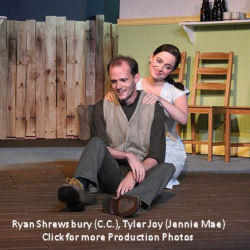 In the lead performance positions were Liam Johnson/FB as Buddy Layman and Ryan Shrewsbury (FB) as C.C. Showers. Johnson gave a great performance as Buddy, capturing the mental impairment in an effective but not overdone way. You could see his fear of water, his expression of talent, and his mental quirks quite well. Shrewsbury was an effective C.C.: thin, friendly, and able to project an ability to reach people, he was believable as an preacher who had lost the calling — in fact, who wanted to distance himself from it completely. You had the sense that there was some reason why — some way that God had failed him — but it never came out or was said. Great performances.
In the lead performance positions were Liam Johnson/FB as Buddy Layman and Ryan Shrewsbury (FB) as C.C. Showers. Johnson gave a great performance as Buddy, capturing the mental impairment in an effective but not overdone way. You could see his fear of water, his expression of talent, and his mental quirks quite well. Shrewsbury was an effective C.C.: thin, friendly, and able to project an ability to reach people, he was believable as an preacher who had lost the calling — in fact, who wanted to distance himself from it completely. You had the sense that there was some reason why — some way that God had failed him — but it never came out or was said. Great performances.
Rounding out the Layman family were Tyler Joy (FB) as Jennie Mae Layman and Harry Bennett/FB as Ferris Layman. I fell in love with Joy’s portrayal of Jennie Mae — she radiated a distinct sweetness and caring and naivete that was wonderful to watch. Bennett’s Ferris was an interesting father figure — intensely disliking Herbert Hoover, and seemingly unsure how to handle his children — in fact, his way to handle his children was not to handle them — to let them grow as weeds do, finding their own path. Bennett performed that well.
Rounding out the community of Zion IN were the rest of the townfolk: Gin Treadwell-Eng (FB) [Norma Henshaw]; Sanya Arnold/FB [Darlene Henshaw]; Jeni Fitzgerald/FB [Goldie Short]; Randy Aronson (FB) [Basil Bennett]; Laura Lanoil/FB [Luella Bennett]; Barry Agin (FB) [Melvin Wilder], and Curtis Crawford/FB [Dewey Maples]. Crawford and Arnold were convincing as two teens trying to find their way in the world of relationships. Treadwell-Eng, Fitzgerald, and Lanoil were quite convincing as the ladies in the town who simply wanted to see religion back as the central thing in their lives. Aronson’s Basil was a great simple farmer — the side story about his relationship with his bicycle was great.
Turning to the technical side: The scenic design was by Jeffrey Hyde. It was great to see Jeff back doing the design after a long hiatus — it was evident in the quality and the attention to detail in the set (although he does need to replace the CFL in the porch light). In particular, the raised nature of the set to permit digging and to provide for the front lighting was great. Speaking of lighting, the lighting design by Jeffrey Hampton, under the supervision of resident lighting designer Tim Christianson/FB, was very effective. Sound design was by the always effective Steven “Nanook” Burkholder/FB. The costumes by Janet McAnany (FB) and Kristi Johnson/FB were effective and seemed reasonably period. Remaining technical credits: Assistant Director – Michael Keane/FB; Production Stage Manager – Kim Iosue/FB. REP is under the artistic direction of Mikee Schwinn/FB.
The Diviners continues at Repertory East Playhouse (FB) in Newhall until October 16. Tickets are available through the REP website or on Goldstar. Even with the weak resolution to the story, it is well worth seeing for the slice of life it creates and the extraordinary performances.
Ob. Disclaimer: I am not a trained theatre critic; I am, however, a regular theatre audience member. I’ve been attending live theatre in Los Angeles since 1972; I’ve been writing up my thoughts on theatre (and the shows I see) since 2004. I do not have theatre training (I’m a computer security specialist), but have learned a lot about theatre over my many years of attending theatre and talking to talented professionals. I pay for all my tickets unless otherwise noted. I am not compensated by anyone for doing these writeups in any way, shape, or form. I subscribe at three theatres: REP East (FB), The Colony Theatre (FB), and Cabrillo Music Theatre (FB). Through my theatre attendance I have made friends with cast, crew, and producers, but I do strive to not let those relationships color my writing (with one exception: when writing up children’s production, I focus on the positive — one gains nothing except bad karma by raking a child over the coals). I believe in telling you about the shows I see to help you form your opinion; it is up to you to determine the weight you give my writeups.
Upcoming Shows: Next weekend sees us going down to La Mirada to see “First Date” at The La Mirada Theatre for the Performing Arts (FB). October was being held for the NoHo Fringe Festival (FB), but they haven’t put up the Fringe shows yet, so I’ve started booking weekends. The first weekend of October brings “The Baker’s Wife” at Actors Co-op (FB) in Hollywood. The second weekend of October brings “The Best of Enemies” at The Colony Theatre (FB). The third weekend of October takes us to Thousand Oaks for “Damn Yankees” at Cabrillo Music Theatre (FB). The fourth weekend of October brings “Uncle Vanya” at Antaeus Theatre Company (FB) in North Hollywood. Halloween weekend sees me at CSUN for Urinetown, and then both of us out in Simi Valley for “The Addams Family” at the Simi Cultural Arts Center (Simi Actors Rep Theatre (FB)). The following weekend sees us back in Simi for the Nottingham Festival (FB) on November 7. We then go out to Perris for “A Day Out with Thomas” at Orange Empire Railway Museum (FB) on November 11 (I can’t skip seeing my buddy Thomas and his friend Percy). The bookings for November conclude with Deathtrap at REP East (FB) on November 14; the rest of the month is currently open. December brings “Humble Boy” at The Colony Theatre (FB) the first weekend, followed by a mid-week stint as a producer, when we present The Nigerian Spam Scam Scam as the dinner entertainment at the Annual Computer Security Applications Conference (ACSAC). December also has dates held for “The Bridges of Madison County” at the Ahmanson Theatre (FB) and “If/Then” at the Pantages (FB). There are also a few other interesting productions I’m keeping my eyes open for. The first is the Fall show at The Blank Theatre (FB), “Something Truly Monstrous”, sounds wonderful — however, it runs through November 8, so squeezing it in would mean a double weekend. The show at the Kirk Douglas Theatre (FB) also sounds like an interesting exploration of clutter — but “The Object Lesson” only runs through October 4, and I’m not sure we can squeeze it in. As always, I’m keeping my eyes open for interesting productions mentioned on sites such as Bitter-Lemons, and Musicals in LA, as well as productions I see on Goldstar, LA Stage Tix, Plays411.



 [Note: Although I’m posting this on
[Note: Although I’m posting this on 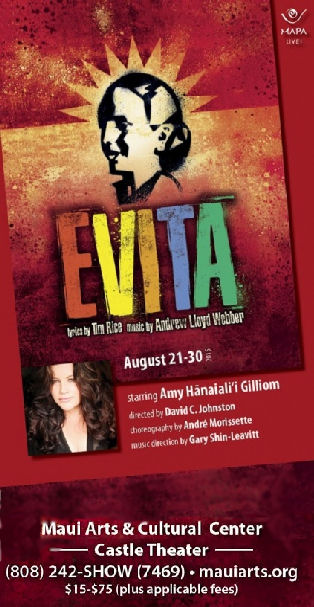
 Just because we are on vacation doesn’t mean the theatre stops. When I’m on vacation, I typically try to see at least one local show. When I confirmed we were going to
Just because we are on vacation doesn’t mean the theatre stops. When I’m on vacation, I typically try to see at least one local show. When I confirmed we were going to 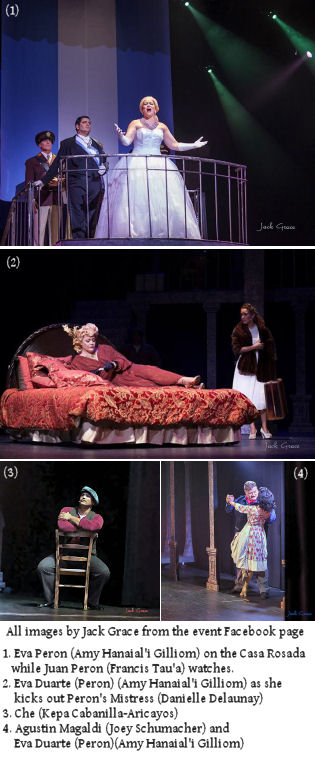



 When you are talking about situational humor, you can never go wrong with a situation that involves an odd man out, or as they taught on Sesame Street: “Which one of these things is not like the other?” This is the premise of the current show, The Fabulous Lipitones, at
When you are talking about situational humor, you can never go wrong with a situation that involves an odd man out, or as they taught on Sesame Street: “Which one of these things is not like the other?” This is the premise of the current show, The Fabulous Lipitones, at 
 Green grow the lilacs, all sparkling with dew,
Green grow the lilacs, all sparkling with dew,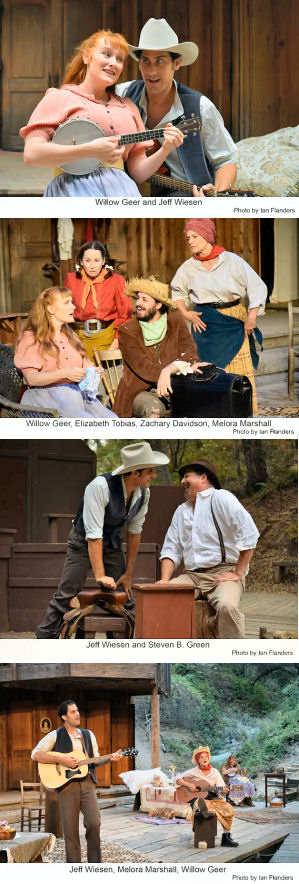 The acting was top right — especially when you consider that the same lead actresses had leading roles in the previous day’s As You Like It, where they played Rosalind, Cellia, and Jaques. How they remember all the dialogue astounds me. Our lead couple was
The acting was top right — especially when you consider that the same lead actresses had leading roles in the previous day’s As You Like It, where they played Rosalind, Cellia, and Jaques. How they remember all the dialogue astounds me. Our lead couple was 
